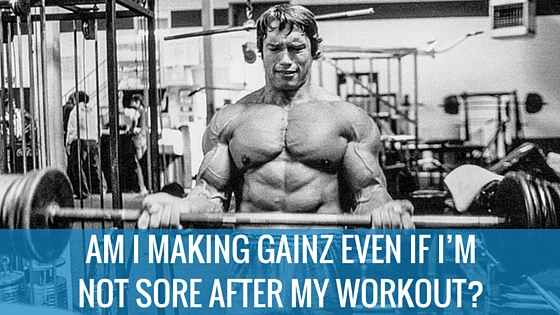tl;dr: Muscle soreness does not equal gainz. You don’t need to be incredibly sore to achieve progress.
It’s Monday morning and you wake up feeling refreshed and great even though you crushed your leg workout yesterday.
Like seriously crushed it.
In your mind you’re dreading getting out of bed, because your legs are probably dead, and you’re positive you’ll fall to the ground like a newborn giraffe.

When you finally work up the courage to get out of bed your legs are barely sore, and actually feel pretty good. Obviously fatigued, but not the intense pain you wanted or expected to feel.
“Fuck” you think out loud to yourself.
Does this mean you didn’t push yourself hard enough? Are your legs forever going to remain chicken legs? Did you do something wrong?
Let’s just get to the real question at hand. Is soreness a good indicator of muscle growth?
The short of it is No. You don’t have to be sore to make progress.
Even in high school I was taught that a good workout made you sore because that pain was your muscle fibers tearing, and your body healing them (not far from the truth).
Therefore, “No pain, no gain”
We’ve all heard it.
I believed it. I believed it for a long time. So I’d push myself in workouts. I’d be super disappointed when I wasn’t sore.
Even to the point of giving up at times.
Fortunately for everyone soreness isn’t necessarily the best indicator of progress.
Let’s address a couple of things real quickly.
When you are sore, what is the soreness you’re feeling?
It’s called DOMS or Delayed Onset Muscle Soreness.
Summarized DOMS occurs when your tissue experiences micro-trauma, and is most often associated with the eccentric (lengthening) portion of the movement.
You can start to feel DOMS within a few hours of working out, but the real pain begins (or peaks) 24-72 hours in. It also varies from person to person, I know some people that get sore almost every time they work out when they are fairly advanced lifters, and beginners that have killed it in the gym and rarely get sore.
Personally when I am experiencing DOMS it peaks about 48-72 hours in.
This pain can last for up to a week, sometimes a bit longer.
You’ve probably experienced this on a really intense leg day, especially early on when getting into weight lifting.
You’re most likely to experience DOMS when you’re a beginner in weight training, or you introduce a new variable into your training program (100 wall balls instead of 4×10 squat anyone?)
If you start a squat program, and you’re squatting 3 days per week for the next six weeks. You better believe you’ll probably be sore the first couple of weeks. Especially if you’re only used to squatting only 1 day per week. But does that mean that by week 3 or 4 you’re no longer making gains?
Not at all.
So how do you know if you’re making gainz?
In short the best way to make sure you’re continually making progress is to:
- Keep a training journal
- Take measurements
- Take pictures
Make sure you’re measuring and keeping track of your progress.
While you can make plenty of progress without keeping track of variables, it does make it much easier to continually make progress and not hit a huge plateau. From week to week you should be progressing in some way. If you’re following a program, you should be able to keep track of weights/reps and even rest periods. All things you can change to make the workout more intense. If you need a workout program apply for my online coaching.
The take home notes:
You don’t have to achieve muscle soreness to make progress. Use other tools that over time will help show you the progress you’re making.

